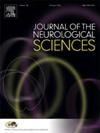磁共振指纹识别在区分癫痫性与非癫痫性皮质畸形中的应用
IF 3.2
3区 医学
Q1 CLINICAL NEUROLOGY
引用次数: 0
摘要
目的探讨磁共振指纹识别(MRF)作为一种无创方法鉴别癫痫性和非癫痫性皮质畸形的潜力。方法69例受试者:4例复杂皮质畸形患者术前进行详细评估,包括立体脑电图(SEEG)和/或后续手术,17例组织病理学证实为FCD II, 48例健康对照(HC)。所有受试者都进行了全脑3t磁共振成像采集,重建后生成T1和T2弛缓测量图。为每个病变创建3D ROI,并使用HC数据进行基于ROI的z评分归一化,以最大限度地减少病变位置的偏差。在病例1-3(每个病例有多个病变)中进行患者内比较;病例1、2和4(影像学诊断为FCD II)使用组织病理学证实的癫痫性FCD II病变参考文库进行患者间比较。区分癫痫性和非癫痫性皮质畸形的最有效的MRF措施是根据其与SEEG结果、手术位置和癫痫发作结果的一致性来确定的。结果与非癫痫性畸形相比,所有4例癫痫性畸形患者的灰质(GM) T1值均显著升高。在病例4中,MRI阴性的癫痫发生区表现出比正常皮质更高的GM和白质(WM) T1和T2值,这在常规MRI上是无法检测到的,突出了这些测量的敏感性。定量MRF指标,特别是GM T1,有望作为一种非侵入性工具来区分癫痫性和非癫痫性皮质畸形。当存在复杂/多发性皮质畸形时,我们的方法可以帮助SEEG植入和手术计划。本文章由计算机程序翻译,如有差异,请以英文原文为准。
Utility of MR fingerprinting in differentiating epileptogenic from non-epileptogenic cortical malformations
Objective
This study investigates the potential of magnetic resonance fingerprinting (MRF) as a non-invasive method to differentiate epileptogenic from non-epileptogenic cortical malformations.
Methods
Sixty-nine subjects were included: four patients with complex cortical malformations who underwent detailed pre-surgical assessments including Stereo-EEG (SEEG) and/or subsequent surgery, 17 with histopathologically confirmed FCD II, and 48 healthy controls (HC). All subjects underwent a whole-brain 3 T MRF acquisition, the reconstruction of which generated T1 and T2 relaxometry maps. A 3D ROI was created for each lesion, and ROI-based z-score normalization using HC data was performed to minimize bias from lesion location. Within-patient comparisons were performed in Cases 1–3 (each with multiple lesions); across-patient comparisons were performed in Cases 1, 2, and 4 (with radiologically diagnosed FCD II), using a reference library of histopathologically confirmed, epileptogenic FCD II lesions. The most effective MRF measures for distinguishing epileptogenic from non-epileptogenic cortical malformations were identified based on their concordance with SEEG findings, surgical location and seizure outcomes.
Results
In all four cases, epileptogenic malformations showed significantly increased gray-matter (GM) T1 values compared to non-epileptogenic ones, both within and across patients. In Case 4, an MRI-negative epileptogenic region exhibited elevated GM and white-matter (WM) T1 and T2 values than normal cortex, which was undetectable on conventional MRI, highlighting the sensitivity of these measures.
Significance
Quantitative MRF metrics, especially GM T1, hold promise as a non-invasive tool to to differentiate epileptogenic from non-epileptogenic cortical malformations. Our approach could aid SEEG implantation and surgical planning when complex/multiple cortical malformations are present.
求助全文
通过发布文献求助,成功后即可免费获取论文全文。
去求助
来源期刊

Journal of the Neurological Sciences
医学-临床神经学
CiteScore
7.60
自引率
2.30%
发文量
313
审稿时长
22 days
期刊介绍:
The Journal of the Neurological Sciences provides a medium for the prompt publication of original articles in neurology and neuroscience from around the world. JNS places special emphasis on articles that: 1) provide guidance to clinicians around the world (Best Practices, Global Neurology); 2) report cutting-edge science related to neurology (Basic and Translational Sciences); 3) educate readers about relevant and practical clinical outcomes in neurology (Outcomes Research); and 4) summarize or editorialize the current state of the literature (Reviews, Commentaries, and Editorials).
JNS accepts most types of manuscripts for consideration including original research papers, short communications, reviews, book reviews, letters to the Editor, opinions and editorials. Topics considered will be from neurology-related fields that are of interest to practicing physicians around the world. Examples include neuromuscular diseases, demyelination, atrophies, dementia, neoplasms, infections, epilepsies, disturbances of consciousness, stroke and cerebral circulation, growth and development, plasticity and intermediary metabolism.
 求助内容:
求助内容: 应助结果提醒方式:
应助结果提醒方式:


